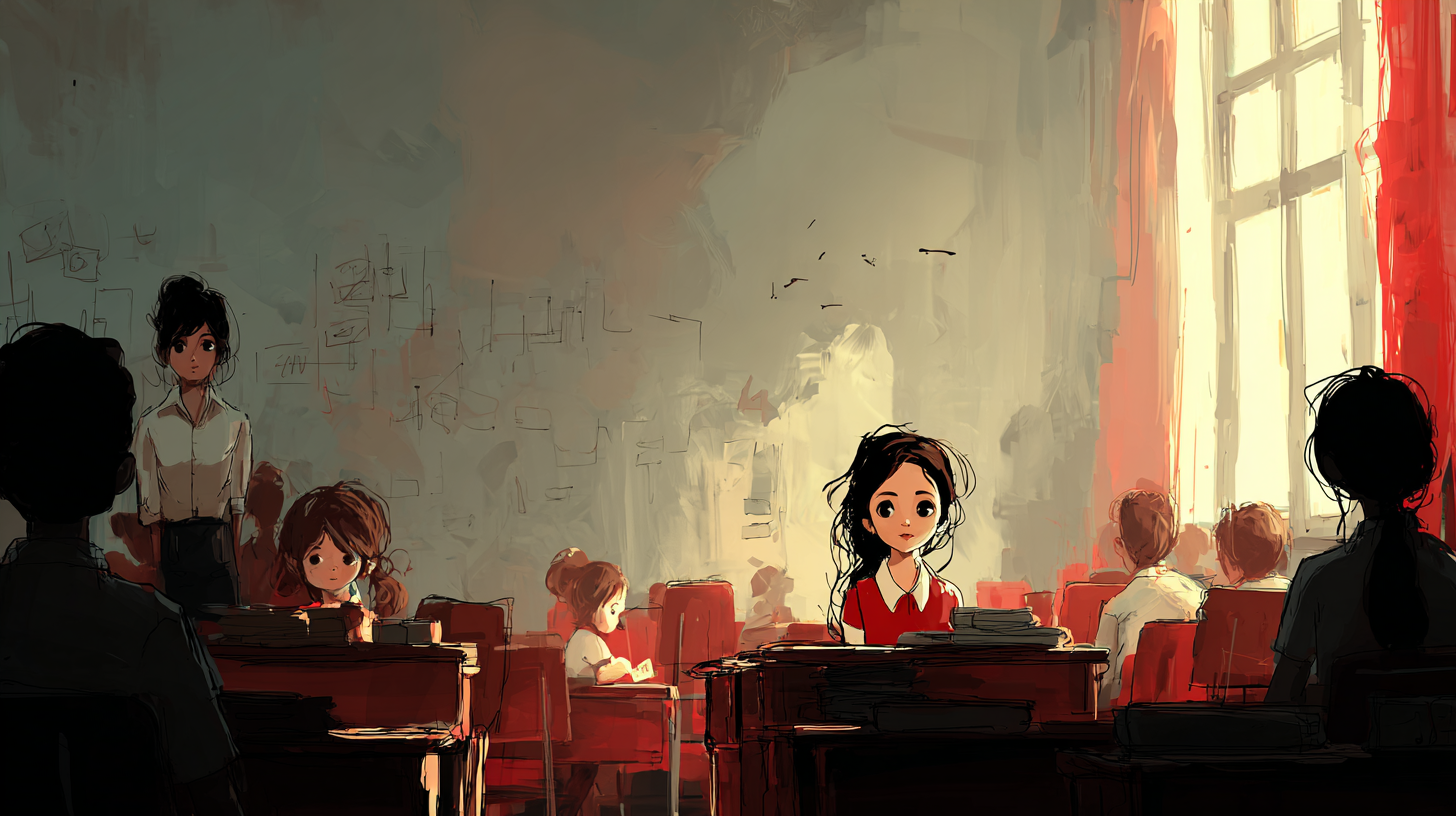“Pupil” means a young student or the black center part of the eye.
「pupil」は、「小学生くらいの子ども」または「目の黒い真ん中の部分」を意味します。
以下は英単語 “pupil” に関するストーリー型学習コンテンツです。まずは大枠の意味を理解して最後の文章で確認しましょう。
主な意味(main meaning)
| 品詞 | 意味 | 発音記号 | 英語例文 |
|---|---|---|---|
| 名詞 | 生徒(特に学校の児童) | /ˈpjuː.pəl/ | The pupil raised her hand to ask a question. |
| 名詞 | 瞳孔(目の中心の黒い部分) | /ˈpjuː.pəl/ | The doctor looked into the pupil of his eye. |
語源(etymology)
語源はラテン語の「pupillus」(保護された子ども、孤児)に由来します。後に「教えられる子ども」や「目の小さな人のように見える部分(瞳孔)」という意味に派生しました。
核となるイメージ: 「小さく守られている存在」
類義語(synonyms)
| 類義語 | 例文 |
|---|---|
| student | The student studied hard for the final exam. |
| learner | Every learner has a different style of understanding. |
| child | The child played outside during recess. |
| schoolchild | A schoolchild must wear a uniform at that school. |
| trainee | The trainee listened carefully to the instructions. |
反義語(antonyms)
| 反義語 | 例文 |
|---|---|
| teacher | The teacher explained the topic clearly. |
| adult | An adult should always be responsible. |
コロケーション(collocations)
| コロケーション | 例文 |
|---|---|
| primary school pupil | A primary school pupil must wear a badge. |
| bright pupil | She is known as a bright pupil in science class. |
| new pupil | The new pupil was welcomed by the whole class. |
| pupil’s progress | The teacher checks each pupil’s progress weekly. |
| discipline a pupil | Sometimes the teacher needs to discipline a pupil. |
2項表現(binomials)
| 2項表現 | 例文 |
|---|---|
| teacher and pupil | A good relationship between teacher and pupil is important. |
| eyes and pupils | His eyes and pupils were checked during the exam. |
英語ストーリー(english story)
Title: The New Pupil
On Monday morning, a new pupil named Aya joined the primary school. She had just moved from another city and felt nervous. Her pupil’s eyes looked around the classroom, searching for a friendly face.
Ms. White, the teacher, smiled and said, “Aya, please take a seat next to Sara.” Aya walked over quietly and sat down. Sara whispered, “Don’t worry. I was a new pupil last year. You’ll like it here.”
Aya noticed that Sara was a bright pupil, always answering questions. During science class, the teacher said, “Look into your partner’s eye and describe the pupil.” Aya and Sara looked at each other and wrote their answers.
At lunchtime, Aya played with her new classmates. She began to feel more confident. Later, Ms. White checked each pupil’s progress and praised Aya for her efforts.
That day, Aya learned not only about eyes and pupils, but also about friendship and courage.
和訳
タイトル:新しい生徒
月曜日の朝、新しい**生徒(pupil)のアヤが小学校にやってきました。彼女は別の町から引っ越してきたばかりで、緊張していました。アヤの瞳(pupil)**は教室内を見回し、やさしそうな顔を探していました。
先生のホワイトさんは微笑んで言いました。「アヤ、サラの隣に座ってください。」アヤは静かに歩いて行って座りました。サラはささやきました。「大丈夫よ。私も去年は**新しい生徒(new pupil)**だったの。ここは楽しいわよ。」
アヤはサラがいつも質問に答える**賢い生徒(bright pupil)**であることに気づきました。理科の時間、先生が言いました。「パートナーの目を見て、**瞳(pupil)**を観察して説明しましょう。」アヤとサラはお互いの目を見て、答えを書きました。
昼休み、アヤはクラスメートたちと遊びました。少しずつ自信がついてきました。後でホワイト先生は**生徒の進歩(pupil’s progress)**を確認し、アヤの努力をほめました。
その日、アヤは**目と瞳(eyes and pupils)**についてだけでなく、友情と勇気についても学びました。
Q&A
- Q「pupil」と「student」の違いは何ですか?
- A
「pupil」は主に小学生などの初等教育に通う子どもに使われる言葉です。一方「student」は年齢に関係なく、学校や大学などで学ぶ人すべてに使えます。日本語で言えば、「pupil」は「児童」、「student」は「生徒・学生」というイメージです。
- Q「pupil」と「learner」の違いは何ですか?
- A
「learner」は「学ぶ人」全般を指し、学習者という広い意味を持ちます。年齢や場所を問わず、独学の人や大人の学習者も含みます。一方「pupil」は学校に通う若い子どもに限って使われることが多いです。
- Q「pupil」と「child」の違いは何ですか?
- A
「child」は年齢的な意味での「子ども」を指し、学習とは関係ありません。「pupil」は「子どもの中でも、学校に通って勉強している子」を意味します。つまり、「pupil」は「child」でありながら、学習者という立場を持っています。
- Q「pupil」と「schoolchild」の違いは何ですか?
- A
どちらも「学校に通う子ども」という意味でほぼ同じですが、「schoolchild」はより形式的・客観的に使われ、「pupil」は教育現場や日常的な文脈でよく使われます。微妙なニュアンスの違いですが、使用場面が異なります。
- Q「pupil」と「trainee」の違いは何ですか?
- A
「trainee」は「職業訓練を受けている人」を意味し、職場などで特定の技術を習得中の人に使います。「pupil」は学校に通う子どもを指すため、教育機関と職業訓練の違いがあります。
- Q「pupil」と「teacher」の関係はどう違いますか?
- A
「pupil」は教えられる立場、「teacher」は教える立場にあります。両者は教育の基本的な関係で、相互に役割が対になっています。「pupil」は学ぶ人、「teacher」は導く人です。
- Q「pupil」と「adult」の違いは何ですか?
- A
「adult」は「大人」を意味し、年齢的に成熟した人を指します。一方「pupil」は若い学習者、特に児童を指します。対義的な関係にあり、年齢・立場が対照的です。
- Q「pupil」と「bright pupil」はどう違いますか?
- A
「pupil」はただの生徒ですが、「bright pupil」は「頭の良い生徒」や「よくできる生徒」という意味になります。形容詞「bright」が加わることで、能力の高さを強調します。
- Q「pupil」と「new pupil」はどう違いますか?
- A
「pupil」は一般的な生徒、「new pupil」は新しく入ってきたばかりの生徒を指します。「new」が加わることで、その生徒がまだ慣れていない存在であることがわかります。
- Q「pupil」と「pupil’s progress」はどう違いますか?
- A
「pupil」は生徒そのものを指し、「pupil’s progress」はその生徒がどれくらい学びを進めているか、成績や理解度の進み具合を指します。「progress」は進歩・成長を意味します。



コメント